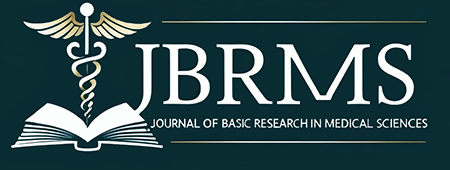Volume 11, Issue 4 (9-2024)
jbrms 2024, 11(4): 12-19 |
Back to browse issues page
Download citation:
BibTeX | RIS | EndNote | Medlars | ProCite | Reference Manager | RefWorks
Send citation to:



BibTeX | RIS | EndNote | Medlars | ProCite | Reference Manager | RefWorks
Send citation to:
Nozari A, Hassani M, Karimzad Hagh J, Sadeghi A, Jalilian N. Clinical and Molecular Genetic Characterization of a Female with Fragile X Syndrome and Two Expanded Alleles: A Case Report. jbrms 2024; 11 (4) :12-19
URL: http://jbrms.medilam.ac.ir/article-1-845-en.html
URL: http://jbrms.medilam.ac.ir/article-1-845-en.html
Sadra Medical Genetics Laboratory, Shahrekord, Iran & Medical Genetics laboratory, Shahrekord University Medical Sciences, Shahrekord, Iran of , ahouranozari@gmail.com
Abstract: (1279 Views)
Fragile X syndrome is a genetic condition causing a range of developmental problems, with males more severely affected compared to female patients. The main features include a long and narrow face, large ears, and a prominent jaw and forehead. Males develop enlarged testicles after puberty, and carrier females are expected to show fragile X-associated primary ovarian insufficiency (FXPOI). Fragile X Syndrome (FXS) was suspected in a consanguineous family referred to a Medical Genetics center because of a family history of intellectual disability and primary ovarian insufficiency in their small village population. The cytosine guanine guanine (CGG) repeat expansion of the FMR1 gene in the 65-year-old proband was amplified and then analyzed by Gene Marker software. The female proband showed two expanded alleles, including one full mutation allele and one premutation allele with an accurate size of 74 (CGG) repeats. Despite having two mutant FMR1 alleles and manifesting some symptoms of FXS, she was fertile. Consanguineous marriages and, in more unfavorable conditions, marrying Fragile X-affected or premutation-carrying males with female carriers is not uncommon in such genetically isolated populations. Therefore, the need for Fragile X syndrome examination in suspected patients with similar features and screening their relatives is highly emphasized.
Type of Study: Research |
Subject:
Genetics
Received: 2024/04/13 | Accepted: 2024/05/20 | Published: 2024/09/18
Received: 2024/04/13 | Accepted: 2024/05/20 | Published: 2024/09/18
References
1. R.J. Hagerman, E. Berry-Kravis, H.C. Hazlett, D.B. Bailey, H. Moine, R.F. Kooy, et al. Fragile X syndrome, Nat. Rev. Dis. Primers. 3 (1) (2017) 1-19,
2. K.G. Monaghan, E. Lyon, E.B. Spector. ACMG Standards and Guidelines for fragile X testing: a revision to the disease-specific supplements to the Standards and Guidelines for Clinical Genetics Laboratories of the American College of Medical Genetics and Genomics, Genet Med .15 (7) (2013) 575-586, https://doi.org/ 10.1038/gim.2013.61 [DOI:10.1038/gim.2013.61]
3. Salcedo-Arellano MJ, Dufour B, McLennan Y, Martinez-Cerdeno V, Hagerman R. Fragile X syndrome and associated disorders: clinical aspects and pathology. Neurobiol. Dis. 2020 Mar 1;136:104740.
4. J. Hunter, O. Rivero‐Arias, A. Angelov, E. Kim, I. Fotheringham, J. Leal. Epidemiology of fragile X syndrome: A systematic review and meta‐analysis, Am. J. Med. Genet. Part A.164 (7) (2014) 1648-1658, https://doi.org/ 10.1002/ajmg.a.36511 [DOI:10.1002/ajmg.a.36511]
5. Hagerman RJ, Protic D, Rajaratnam A, Salcedo-Arellano MJ, Aydin EY, Schneider A. Fragile X-associated neuropsychiatric disorders (FXAND). Front Psychiatry. 2018:564.
6. J. Rohr, E. Allen, K. Charen, J. Giles, W. He, C. Dominguez, et al. Anti-Mullerian hormone indicates early ovarian decline in fragile X intellectual disability (FMR1) premutation carriers: a preliminary study, Hum Reprod. 23 (5) (2008) 1220-1225,
7. A. Sullivan, M. Marcus, M. Epstein, E. Allen, A. Anido, J. Paquin, et al. Association of FMR1 repeat size with ovarian dysfunction, Hum Reprod. 20 (2) (2005) 402-412, https://doi.org/ 10.1093/humrep/deh635 [DOI:10.1093/humrep/deh635]
8. D. Heine‐Suñer, L. Torres‐Juan, M. Morla, X. Busquets, F. Barcelo, G. Pico, et al. Fragile‐X syndrome and skewed X‐chromosome inactivation within a family: A female member with complete inactivation of the functional X chromosome, Am. J. Med. Genet. Part A.122 (2) (2003) 108-114. , https://doi.org/ 10.1002/ajmg.a.20160 [DOI:10.1002/ajmg.a.20160]
9. F.A. Nahhas, T.J. Monroe, T.W. Prior, P.I. Botma, J. Fang, P.J. Snyder, et al. Evaluation of the human fragile X intellectual disability 1 polymerase chain reaction reagents to amplify the FMR1 gene: testing in a clinical diagnostic laboratory, GENET TEST MOL BIOMA.16 (3) (2012) 187-192, https://doi.org/ 10.1089/gtmb.2011.0128 [DOI:10.1089/gtmb.2011.0128]
10. E. Tabolacci, M.G. Pomponi, L. Remondini, R. Pietrobono, V. Nobile, G. Pennacchio, et al. Methylated premutation of the FMR1 gene in three sisters: correlating CGG expansion and epigenetic inactivation, Eur J Med Genet .28 (5) (2020) 567-575, https://doi.org/ 10.1038/s41431-019-0554-7 [DOI:10.1038/s41431-019-0554-7]
11. L. Martorell, M.T. Nascimento, R. Colome, J. Genovés, M. Naudó, A. Nascimento. Four sisters compound heterozygotes for the pre-and full mutation in fragile X syndrome and a complete inactivation of X-functional chromosome: implications for genetic counseling, J. Hum. Genet. 56 (1) (2011) 87-90, https://doi.org/ 10.1038/jhg.2010.140 [DOI:10.1038/jhg.2010.140]
12. P.L. Sorensen, K. Basuta, G. Mendoza-Morales, L.W. Gane, A. Schneider, R. Hagerman, et al. A Fragile X Sibship from a Consanguineous Family with a Compound Heterozygous Female and Partially-Methylated Full Mutation Male, Am. J. Med. Genet. Part A.158 (5) (2012) 1221, https://doi.org/ 10.1002/ajmg.a.35293 [DOI:10.1002/ajmg.a.35293]
13. M.G. Linden, F. Tassone, L.W. Gane, J.L. Hills, R.J. Hagerman, A.K. Taylor. Compound heterozygous female with fragile X syndrome, Am. J. Med. Genet. 83 (4) (1999) 318-321. , https://doi.org/10.1002/(SICI)1096-8628(19990402)83:4<318::AID-AJMG16>3.0.CO;2-Y [DOI:10.1002/(SICI)1096-8628(19990402)83:43.0.CO;2-Y]
14. S. Russo, V. Briscioli, F. Cogliati, M. Macchi, F. Lalatta, L. Larizza. An unusual fragile X sibship: female compound heterozygote and male with a partially methylated full mutation, Clin. Genet. 54 (4) (1998) 309-314, https://doi.org/ 10.1034/j.1399-0004.1998.5440408.x [DOI:10.1034/j.1399-0004.1998.5440408.x]
15. M.R. Hegde, M. Fawkner, B. Chong, J. Mcgaughran, D. Gilbert, D.R. Love. Compound heterozygosity at the FMR1 gene, Genet. Test. 5 (2) (2001) 135-138, https://doi.org/ 10.1089/109065701753145600. [DOI:10.1089/109065701753145600.]
16. J. Macpherson, J. Harvey, G. Curtis, T. Webb, D. Heitz, F. Rousseau, et al. A reinvestigation of thirty three fragile (X) families using probe StB12. 3, Am. J. Med. Genet. 43 (5) (1992) 905-912, https://doi.org/ 10.1002/ajmg.1320430535 [DOI:10.1002/ajmg.1320430535]
17. P. Chaste, C. Betancur, M. Gérard-Blanluet, A. Bargiacchi, S. Kuzbari, S. Drunat, et al. High-functioning autism spectrum disorder and fragile X syndrome: report of two affected sisters, Mol. Autism. 3 (1) (2012) 1-6,
18. A.C. Wheeler, D.B. Bailey Jr, E. Berry-Kravis, J. Greenberg, M. Losh, M. Mailick, et al. Associated features in females with an FMR1 premutation, J. Neurodev. Disord. 6 (1) (2014) 1-14,
19. B. Finucane, L. Abrams, A. Cronister, A.D. Archibald, R.L. Bennett, A. Mcconkie-Rosell. Genetic counseling and testing for FMR1 gene mutations: practice guidelines of the national society of genetic counselors, J. Genet. Couns. 21 (6) (2012) 752-760, https://doi.org/ 10.1007/s10897-012-9524-8 [DOI:10.1007/s10897-012-9524-8]
20. M.F. Arlt, S.G. Durkin, R.L. Ragland, T.W. Glover. Common fragile sites as targets for chromosome rearrangements, DNAREP. 5 (9-10) (2006) 1126-1135,
Send email to the article author
| Rights and permissions | |
 |
This work is licensed under a Creative Commons Attribution-NonCommercial 4.0 International License. |





